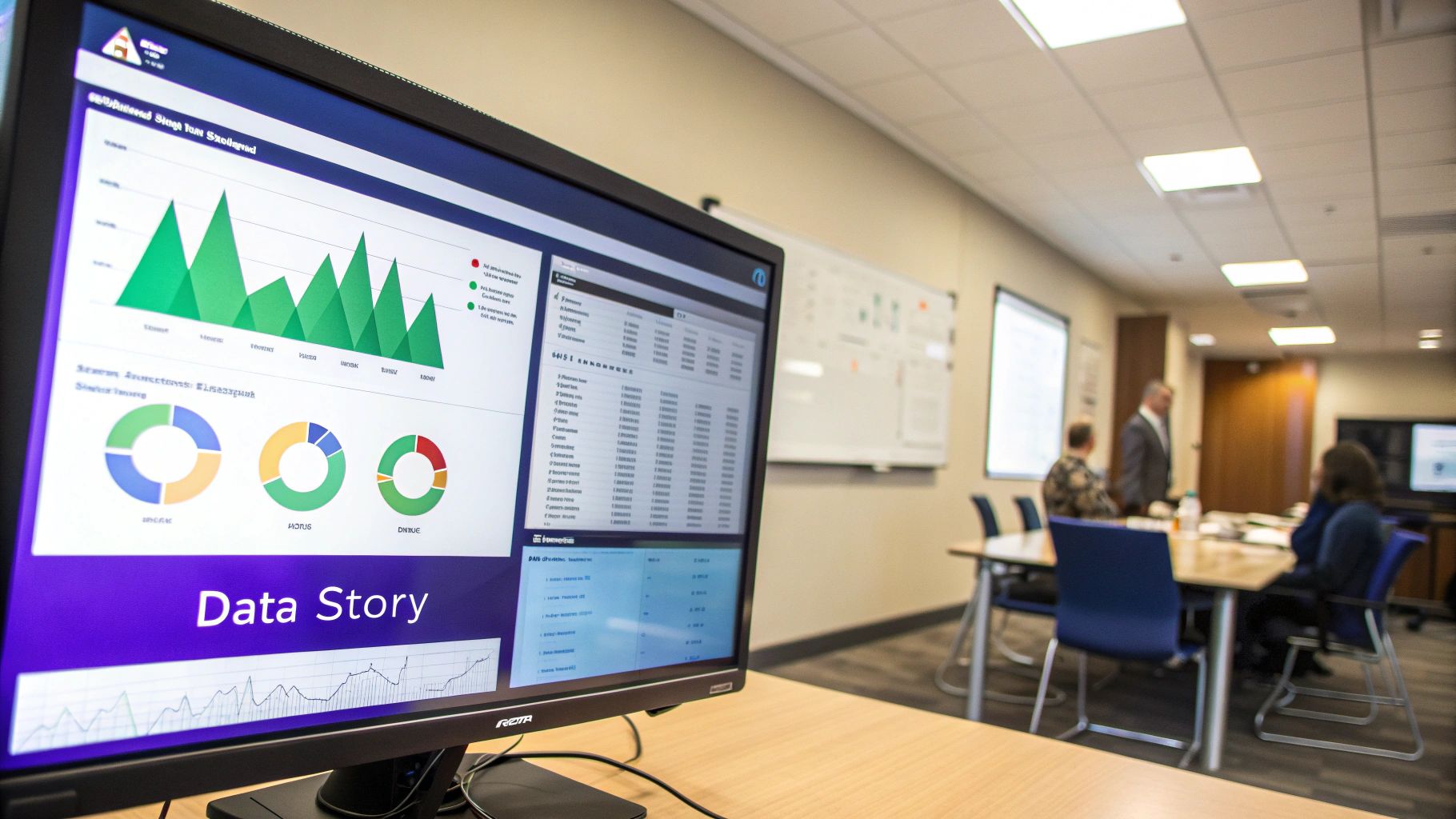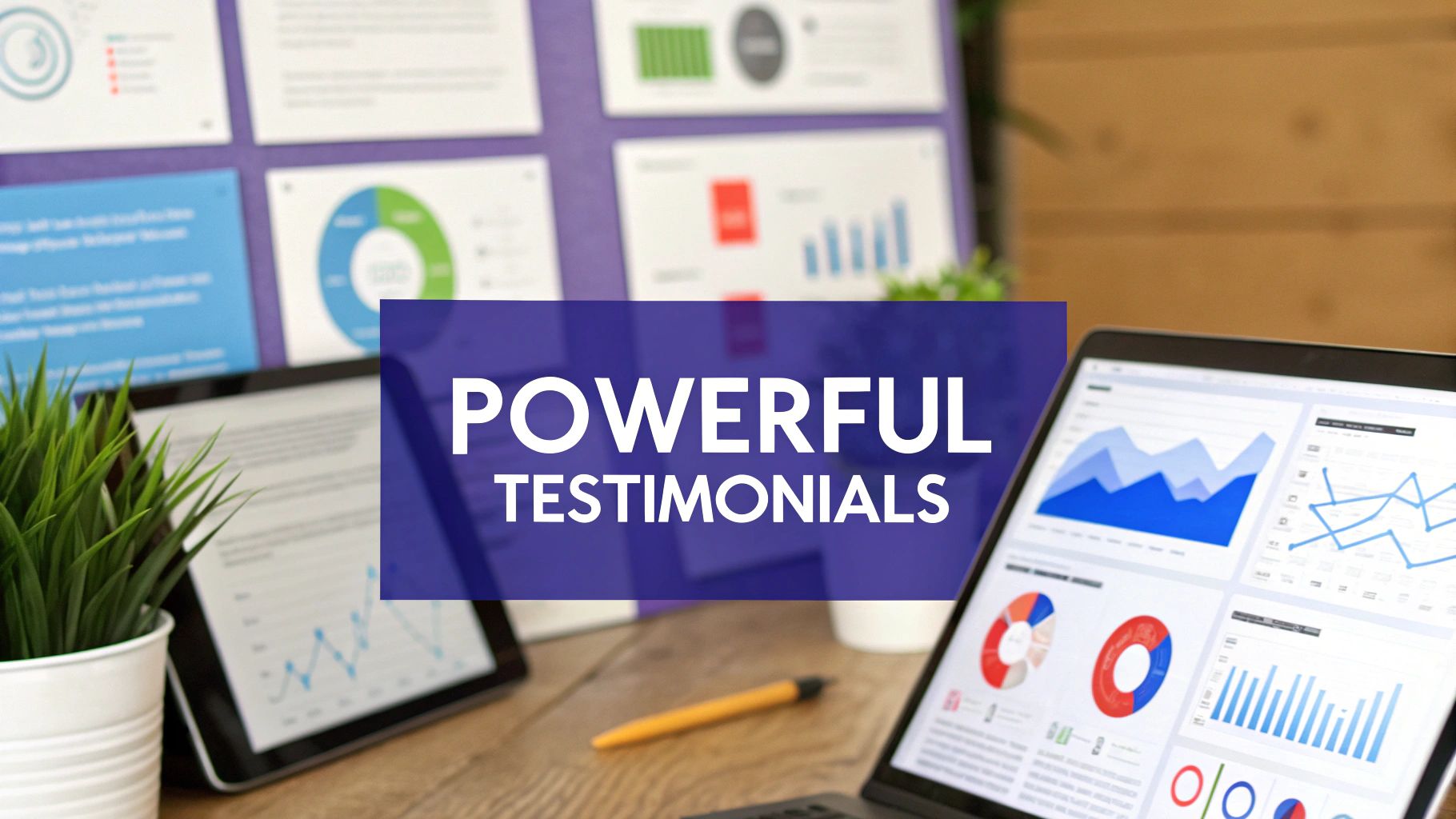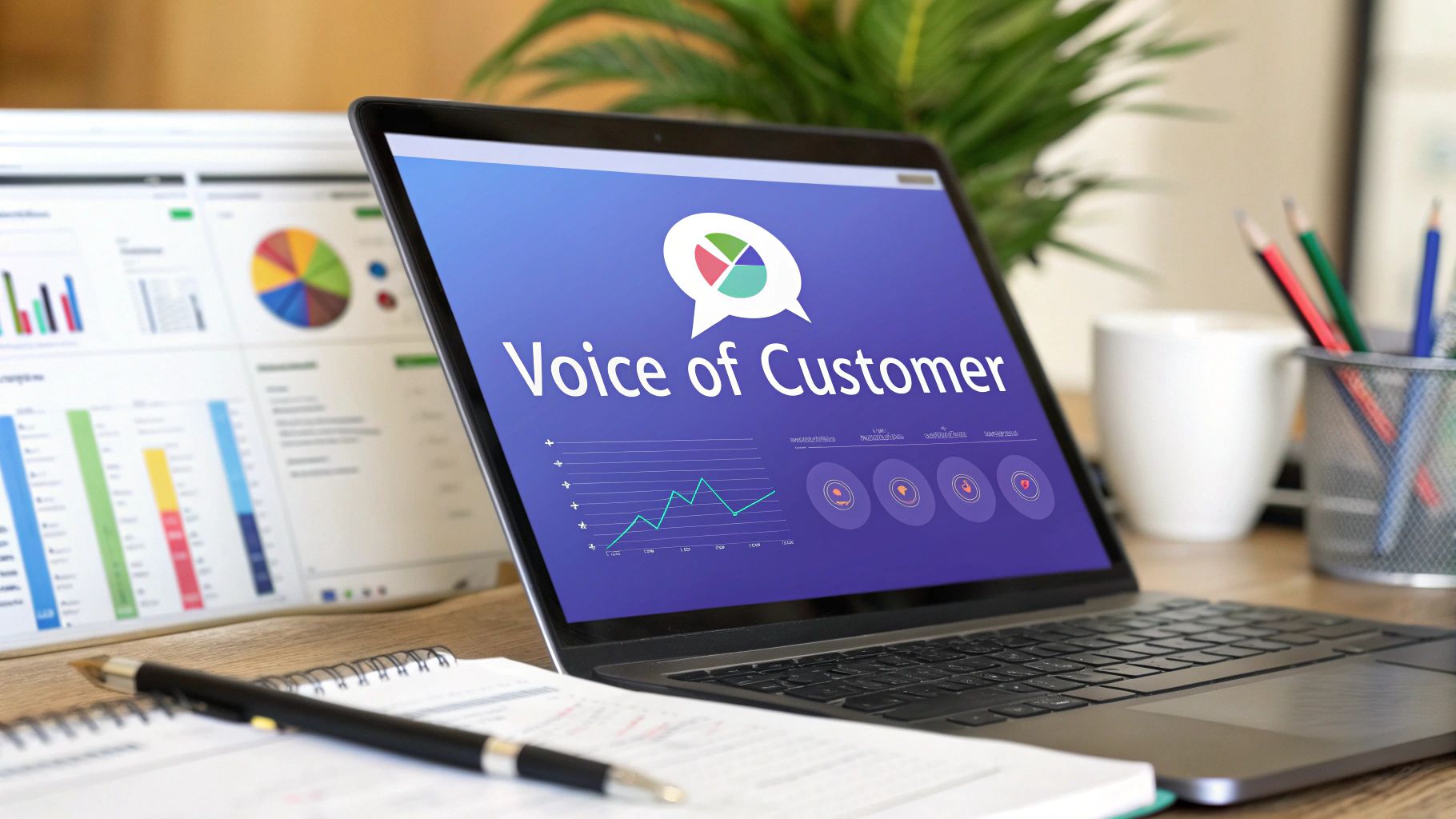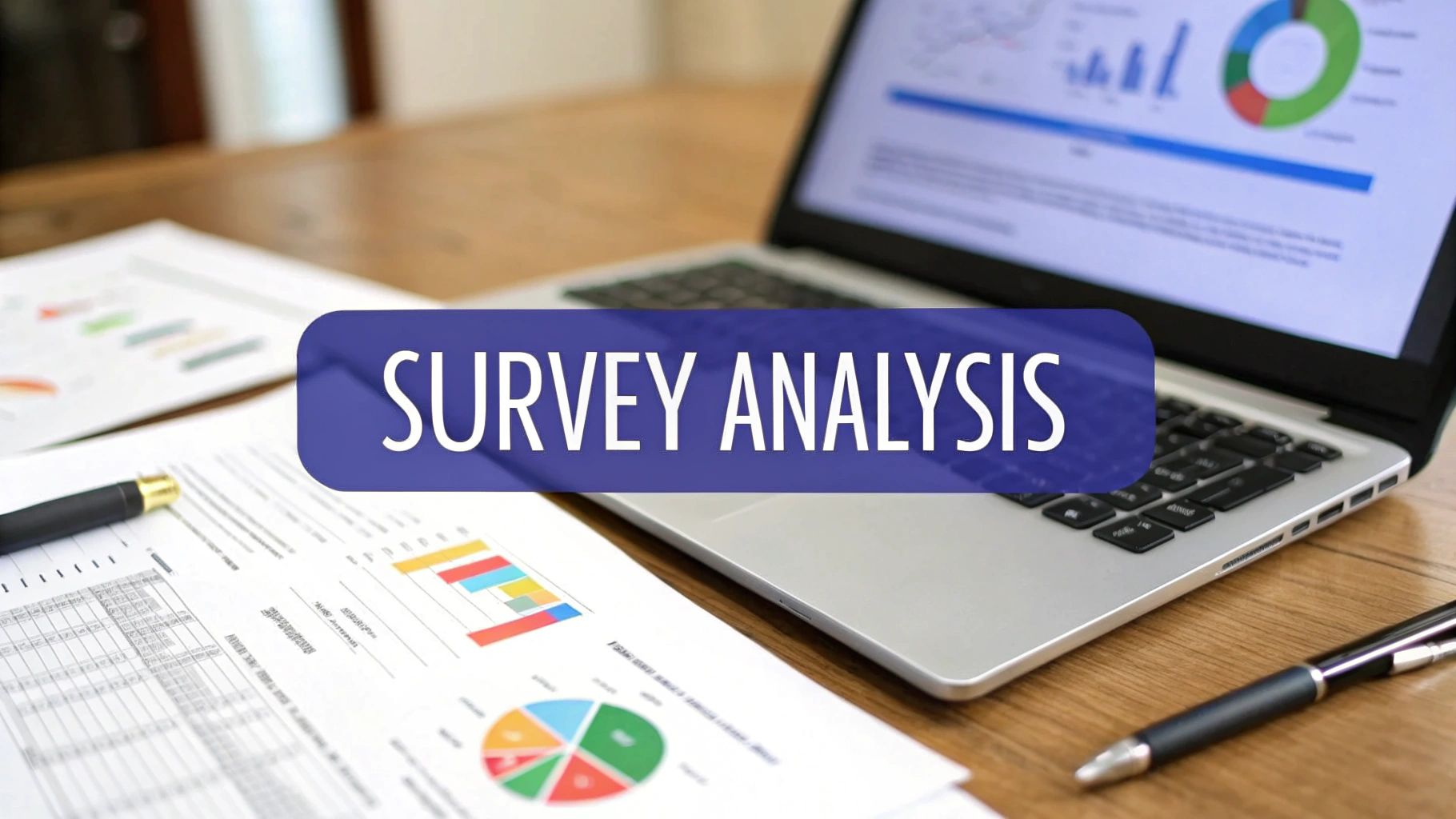Master Analyzing Survey Data for Actionable Insights
Learn essential techniques for analyzing survey data to extract valuable insights. Improve decision-making with our comprehensive guide.

So, you've sent out your survey and the responses are rolling in. What now? This is where the real work begins. Analyzing survey data is about turning those raw answers into clear, actionable insights that can drive decisions.
It's about finding the story hidden in the numbers and text. You transform what people said into a clear picture that guides your strategy. This process is your key to knowing what your audience thinks, needs, and cares about.
What Analyzing Survey Data Really Means
Before you open a spreadsheet or look at a chart, you need to know why you're doing this. The entire process hinges on one simple question: What do you want to learn?
Are you trying to figure out why customers are leaving? Or maybe you're looking for feedback to improve a new feature? Nailing down a clear objective from the start is the single most important step you can take. Your goal frames everything you do next, from how you clean the data to which charts you build. Without a specific question to answer, you'll just be swimming in numbers and end up with a bunch of observations instead of real insights.
Understanding Your Data Types
Once your goal is set, you'll find you're working with two main types of information in your survey responses. Knowing the difference is basic to getting your analysis right.
- Quantitative Data: This is all your numerical stuff. Think ratings on a scale of 1-10, multiple-choice selections, or anything else you can count. This data gives you the "what" like the percentage of users who are satisfied or how many people chose a specific option.
- Qualitative Data: This is the text-based feedback. It comes from those open-ended questions like, "What can we do better?" or "Describe your experience." This data provides the "why" behind the numbers, offering rich context and specific examples that bring the stats to life.
This infographic breaks down the journey from raw data to insights you can actually use.

As you can see, a solid analysis is a structured process. This methodical approach unlocks what your survey responses are really trying to tell you.
The goal is to move beyond simple percentages and find the story your customers are telling you. This story is often the most direct path to improving your product, service, or overall customer experience.
Let's take a quick look at the key phases involved in transforming raw survey responses into strategic insights.
The Core Stages of Survey Data Analysis
These stages provide a roadmap to make sure your efforts lead to meaningful conclusions rather than a collection of random facts.
Ultimately, analyzing survey data is about listening to your audience at scale. When you do it right, you build a solid foundation for making smarter, customer-centric decisions. Examining this data helps you tap into the authentic voice of the customer, which is an incredible asset for any business.
How to Prepare Your Data for Analysis
Before you can pull any meaningful insights from your survey, you have to get your hands dirty with the raw data. This is that make-or-break first step where you clean and organize everything. Rushing it is a classic mistake that leads to unreliable findings and a lot of wasted time.
Think of it like cooking a meal. You wouldn't just toss ingredients into a pan without prepping them first, like washing the veggies and trimming the fat. Data preparation is exactly the same. It's the foundational work that makes sure everything that comes next is solid.
Start with Data Cleaning
Your raw survey data is almost guaranteed to be a little messy. Cleaning is all about finding and fixing these issues to create a dataset you can actually trust. The goal is to make sure every single entry is accurate, consistent, and ready for analysis.
You’ll run into a few usual suspects:
- Incomplete Responses: Some people will inevitably skip questions. You'll need a game plan: do you toss out the entire response, or can you still work with the partial data?
- Duplicate Entries: It happens. Someone might accidentally submit a survey twice. You'll want to hunt down and remove these duplicates to keep them from skewing your results.
- Inconsistent Formatting: This one’s a classic. A simple "Yes/No" question can come back with "y," "yes," "Yes," or even "yeah." Your job is to standardize all of these into a single format, like "Yes."
Another common headache is dealing with oddball answers in specific fields. What happens when someone types "N/A" into a field asking for a numeric rating from 1 to 5? You have to decide how to handle that, either by removing the response or coding it as a null value so it doesn't throw off your calculations.
Create a Data Codebook
Once your data is sparkling clean, it's time to build a data codebook. Think of this as the dictionary for your survey data. It's a central document that defines every single variable in your dataset, so there’s no guesswork involved.
A good codebook clearly explains what each column header means (e.g., "Q1_Satisfaction" actually means "Question 1: How satisfied are you with our service?"). It also defines the values assigned to the answers.
For a satisfaction question, your codebook might look something like this:
- 1 = Very Dissatisfied
- 2 = Dissatisfied
- 3 = Neutral
- 4 = Satisfied
- 5 = Very Satisfied
This document is an absolute lifesaver, especially if you're working with a team or plan to revisit the data down the road. It kills confusion and makes sure everyone is interpreting the data the exact same way. If you’re pulling in data from multiple places, you might hit other roadblocks; our guide on common data integration problems can help you prepare.
Format Your Dataset for Analysis
With clean data and a codebook in hand, the last prep step is to get everything formatted in a tool like Google Sheets or Excel. The gold standard here is to structure your data so that each row represents one respondent and each column represents one variable (or question).
This "tidy data" format is the foundation for pretty much any analysis tool you'll use. It makes it incredibly easy to filter, sort, and run calculations.
For instance, a common cleaning task is getting rid of extra spaces in text entries. A simple function like TRIM in Google Sheets can be a huge time-saver.

This little function automatically cleans up inconsistent spacing in your text-based answers, saving you from a ton of manual work.
Taking the time to properly clean, code, and format your data is a prerequisite for trustworthy analysis. It protects the integrity of your findings and saves you from major headaches down the line.
With all this prep work done, you can confidently move on to the actual analysis, knowing you're working from a solid, reliable foundation.
Choosing the Right Analysis Methods
https://www.youtube.com/embed/XNSB7Ybsdx8
Alright, your survey data is clean, organized, and ready to go. Now for the fun part: finding the answers hidden inside. The key is picking the right analysis method for the job. Different techniques will tell you different parts of the story, and your choice depends entirely on what you want to find out.
Think of it like having a toolbox. You wouldn't use a hammer to turn a screw, right? In the same way, the method you'd use to summarize overall satisfaction is totally different from the one you'd use to compare responses between new and loyal customers. Getting this right is what turns a pile of numbers into a clear direction for your business.
Start with Descriptive Statistics
The most straightforward place to begin is with descriptive statistics. These methods simply summarize your data in a digestible way, giving you a high-level snapshot of what the responses look like. They help you see the big picture before you start drilling down into the finer details.
The three most common descriptive statistics are mean, median, and mode. Each tells you something slightly different about the "typical" response.
- Mean (Average): This is the one we all know. You add up all the numerical responses and divide by the total number of responses. It's great for getting a quick sense of the overall score, like the average satisfaction rating out of 5.
- Median (Middle Value): The median is the number that sits right in the middle of all your responses when they're lined up from smallest to largest. It’s a lifesaver when you have extreme outliers (a few really high or low scores) that could throw off the mean.
- Mode (Most Frequent): This is just the answer that popped up most often. The mode is perfect for multiple-choice questions where you want to identify the most popular option. It can quickly tell you which new feature suggestion was the crowd favorite, for instance.
These simple calculations give you a solid baseline. For example, if the mean satisfaction score is 3.2 but the median is 4.0, that suggests a handful of very unhappy customers are dragging the average down. That's an immediate insight worth digging into.
Compare Groups with Cross-Tabulation
Once you have a general feel for the data, the next logical step is to see how different groups of people answered. This is where cross-tabulation (or crosstabs) shines. This technique involves creating a table to compare the responses of two or more different variables.
It’s an incredibly powerful way to spot relationships between different segments of your audience. You could compare how responses differ by:
- Demographics (e.g., age, location)
- Customer status (e.g., new vs. long-term customers)
- Subscription tier (e.g., free vs. premium users)
Imagine you run a SaaS company and want to know if satisfaction levels are different between users on your free plan and those on your paid plan. A cross-tabulation table would lay out the satisfaction ratings for each group side-by-side, making it easy to spot any major differences. You might discover that paid users are way more satisfied, which could be a huge piece of information for your marketing strategy.
Cross-tabulation moves you from "what" people said to "who" said it and why their perspective might differ. It’s one of the most direct ways to find actionable segments within your audience.
This kind of segmentation is powerful because it mirrors real-world business challenges. Most organizations have to serve diverse groups with different needs. A similar logic applies on a global scale. For instance, the World Bank’s Global Findex Database shows that while a record 82% of adults now have a financial account, huge disparities still exist between and within countries. Analyzing data by segment helps businesses and policymakers address these specific needs more effectively.
Choose the Right Method for Your Question
At the end of the day, selecting the best analytical approach always comes back to your original research questions. Are you looking for a summary, a comparison, or a relationship? A clear goal will always guide you to the right technique. When you're picking an approach, having a solid grasp of market research methodology can be a huge help.
To make this a bit more concrete, here’s a quick rundown of some common analysis methods and when you should pull them out of your toolbox.
Common Analysis Methods and When to Use Them
This table breaks down different analytical techniques to help you choose the best approach for your survey data.
As you can see, each method is designed to answer a different kind of question. Thematic analysis, for example, is very important when you're dealing with open-ended feedback. It involves grouping raw text responses into recurring categories or themes to find patterns.
If you want to get better at that, our guide on how to structure open-ended research questions has some great tips that make the analysis part much easier later on. By having a few of these methods in your back pocket, you can approach your survey data from multiple angles and find layers of insight that a single technique might miss.
Visualizing Survey Data to Tell a Story

Let's be honest, raw numbers and tables are great for digging into the details, but they almost never get people excited. When it’s time to share what you’ve found, visuals are what make your insights stick. A well-designed chart can explain a complex idea in seconds, turning a dry statistic into a powerful piece of evidence.
This is the point where you shift from just analyzing survey data to actually telling a story with it. The goal is to be accurate and persuasive. Your visuals should walk your audience through your findings, building a clear narrative that leads them right to your conclusion.
Choose the Right Chart for Your Data
The first, most important step is picking the right kind of chart. Each one is designed to show a specific type of information, and using the wrong one is a surefire way to confuse your audience. The trick is to match the chart type to the specific story you want to tell.
Here’s a quick rundown of the most common charts I use and what they’re best for:
- Bar Charts: These are your go-to for comparing different categories. They’re perfect for showing things like customer satisfaction scores across different user groups or which product features are most popular.
- Line Graphs: When you need to show a trend over time, a line graph is the undisputed champion. Use it to track metrics like customer happiness month-over-month or how a specific sentiment changed after a product update.
- Pie Charts: Use these with caution, and only when you're showing parts of a whole that add up to 100%. They work best with just a few categories, like breaking down your customer base by subscription plan. Honestly, a bar chart is often a better choice if you have more than four or five slices.
- Scatter Plots: These are fantastic for exploring the relationship between two different numerical variables. A scatter plot can help you see if there’s a connection between how long a customer has been with you and how much they spend, for example.
A classic mistake is using a pie chart to compare four different customer groups' "very satisfied" ratings. The human eye is just so much better at comparing the length of bars than the size of pie slices. A bar chart would tell that story instantly.
Design Visuals for Clarity and Impact
Once you’ve picked the right chart, its design makes all the difference. Your objective is simple: make your visualization so clear and easy to read that the main point hits your audience immediately. They shouldn't have to work for it.
Here are a few practical tips I’ve learned for creating visuals that persuade:
- Keep it simple. Ditch anything that doesn't add real value, like distracting gridlines, weird 3D effects, or a rainbow of unnecessary colors. Less is almost always more.
- Use clear labels. Make sure your axes are clearly labeled, and give your chart a descriptive title that tells the audience exactly what they’re looking at.
- Be smart with color. Use color strategically to highlight the most important data point. For instance, if you want to draw attention to a drop in satisfaction, you could make that part of the line graph red while keeping the rest a neutral grey.
Your visualization should answer a question, not create one. If someone has to spend more than a few seconds figuring out your chart, it’s probably too complicated.
This focus on clarity is important because public sentiment can be complex and shift quickly. For example, recent Ipsos data shows global optimism has dropped, with just 59% of people feeling optimistic about their families, down from 66% a year earlier. Visualizing that trend with a clean line graph makes the decline instantly understandable for any audience.
Use Accessible Tools to Build Your Narrative
You don’t need to be a graphic designer or a data wizard to create professional-looking visuals. Plenty of accessible tools out there make it easy to turn your data into compelling charts and graphs.
Tools like Google Looker Studio, Canva, and even the built-in charting features in Excel or Google Sheets are all fantastic options. They provide templates and user-friendly interfaces that let you focus on the story, not on getting stuck in the technical weeds.
Ultimately, your visuals should work together to build a narrative. Start with a high-level chart that shows the big picture, then use more detailed charts to drill down into specific findings that support your main point. This approach guides your audience logically through your analysis, making your conclusions feel both inevitable and convincing.
How to Interpret Results and Avoid Common Pitfalls
You’ve done the heavy lifting. The data is clean, the analysis is run, and you’ve got a dashboard full of visuals. Now for the most important part: interpretation. This is where raw numbers transform into a story that drives smart decisions. But honestly, it’s also where a lot of great analysis goes completely off the rails.
Drawing the right conclusions is about digging deeper, questioning what you see, and tying it all back to why you ran the survey in the first place. Get this part right, and your analysis stops being a report and starts being a strategic asset.
Look for Patterns and Connect the Dots
The first rule of interpretation is to look for the story. Don't just stare at one chart in isolation. How do the answers to different questions influence one another? The real magic happens when you start connecting the dots.
For example, you might notice that customers who rated your support experience poorly also happen to have the lowest overall satisfaction scores. That's not a coincidence; that's a direct connection. Or maybe you see a huge spike in negative feedback right after a big product update. That’s a clear link between an action your company took and a customer reaction.
Your job is to move beyond just reporting numbers and actively seek out these insights, much like experts are deriving actionable insights from diverse statistical data in all sorts of fields. Instead of saying, "20% of users are unhappy," you can tell a much more powerful story: "20% of users, primarily those who recently contacted support, are unhappy." That simple detail turns a vague stat into a specific, solvable problem.
Correlation Is Not Causation
This is probably the single most common and dangerous trap in data analysis. Just because two things are happening at the same time (correlation) doesn't mean one is causing the other (causation). It’s a classic mistake, and it leads to terrible decisions.
Imagine your survey shows that customers who follow you on social media have a much higher satisfaction rate. The tempting conclusion? "We need to get more social media followers to make customers happier!" But that’s a huge leap. It’s far more likely that your happiest, most engaged customers are the ones who choose to follow you in the first place. The high satisfaction probably caused the follow, not the other way around.
Always challenge your first assumption. Before you declare that A causes B, stop and ask: could there be a third factor, C, that's driving both? Or is it possible the relationship is completely reversed?
Getting this right is basic. If you act on a false assumption of causation, you'll end up wasting time and money on strategies that are doomed to fail.
Account for Bias and Survey Limitations
Let’s be real: no survey is perfect. To interpret your results with integrity, you have to be honest about the potential biases and limitations that might be skewing your findings. Ignoring them leads to overconfidence and bad calls.
Here are a few important things to keep on your radar:
- Survey Bias: This can creep in from all angles. Selection bias is a big one. It happens when your respondents aren't a true mirror of your audience. For example, maybe only your happiest (or angriest) customers bothered to reply. Response bias is when people give answers they think you want to hear, instead of what they truly feel.
- Sample Size: Is your sample big enough to trust? If you only surveyed 50 people out of a 10,000-person user base, the results are shaky at best. A tiny sample size can make random noise look like a significant trend.
- Margin of Error: This number is your reality check. It tells you how much your survey results might differ from the actual views of your entire population. For instance, a margin of error of +/- 5% means that if 60% of your respondents chose an option, the real number for your whole audience is probably somewhere between 55% and 65%.
Being transparent about these limitations doesn't weaken your analysis. It makes it stronger. It shows you've been thoughtful and rigorous, and it helps your team understand the context and confidence level of the findings. This prevents them from treating a preliminary insight as gospel and makes sure your interpretation is both insightful and responsible.
Common Questions About Analyzing Survey Data
Even with a solid plan in place, a few questions inevitably pop up when you first start working with survey data. I've been there. Let's walk through some of the most common ones I hear and get you some clear, straightforward answers.
What Tools Are Best for a Beginner?
When you're just starting out, it's best to stick with the tools you probably already have. Things like Microsoft Excel and Google Sheets are way more powerful than most people give them credit for. You can easily clean up your data, calculate basic stats like averages, and create simple charts without a steep learning curve. Plus, there are endless free tutorials online to help you out.
Once you get the hang of it, you might want to look at the platforms where you collected the data. Tools like SurveyMonkey or Typeform usually have built-in dashboards that do a lot of the initial analysis for you.
Ready to take your visuals up a notch? A free tool like Google Looker Studio is a fantastic next step. It lets you build interactive dashboards that are easy to share, and it's surprisingly intuitive.
How Do I Analyze Open-Ended Questions?
This is where the real gold is often hidden. Analyzing the qualitative, text-based answers from open-ended questions requires a different approach than just crunching numbers. The go-to method here is manual coding.
Don't let the name intimidate you; it's pretty straightforward. Start by reading through a decent sample of the responses. Your goal is to spot recurring themes, common words, or general sentiments that keep popping up. From there, you'll create a few high-level categories.
For instance, you might end up with categories like:
- Positive Feedback on Customer Service
- Suggestions for Product Improvement
- Complaints About App Performance
Once your categories are set, go through every single response and assign it to the right bucket. This process turns all that messy text into neat, quantitative data. Now you can actually count how many times each theme appeared and even create charts to visualize the feedback.
What Is Statistical Significance?
You’ve probably heard this term thrown around. In a nutshell, statistical significance is how you determine if your findings are the real deal or just a random fluke. It helps you answer an important question: is the difference I'm seeing between groups big enough to actually mean something?
Imagine your survey shows that 60% of users in one city love a new feature, while only 55% in another city do. Is that 5% gap a genuine difference in preference, or is it just random noise? Statistical tests give you a "p-value" to help you decide.
If you're steering major business decisions based on small numerical differences, you absolutely need to pay attention to statistical significance. It's the gut check that adds a layer of confidence to your conclusions.
For most general feedback surveys where you're just trying to spot broad trends, you probably don't need to dust off your old stats textbook. Still, it's a good concept to keep in your back pocket. It reminds you that not every number on a chart is a groundbreaking discovery, which helps you interpret your data responsibly and avoid making big calls based on tiny, random variations.
Ready to turn your customer feedback into a growth engine? Surva.ai gives SaaS companies the AI-powered tools to analyze survey data, reduce churn, and collect powerful testimonials automatically. Discover how Surva.ai can help you scale smarter.


